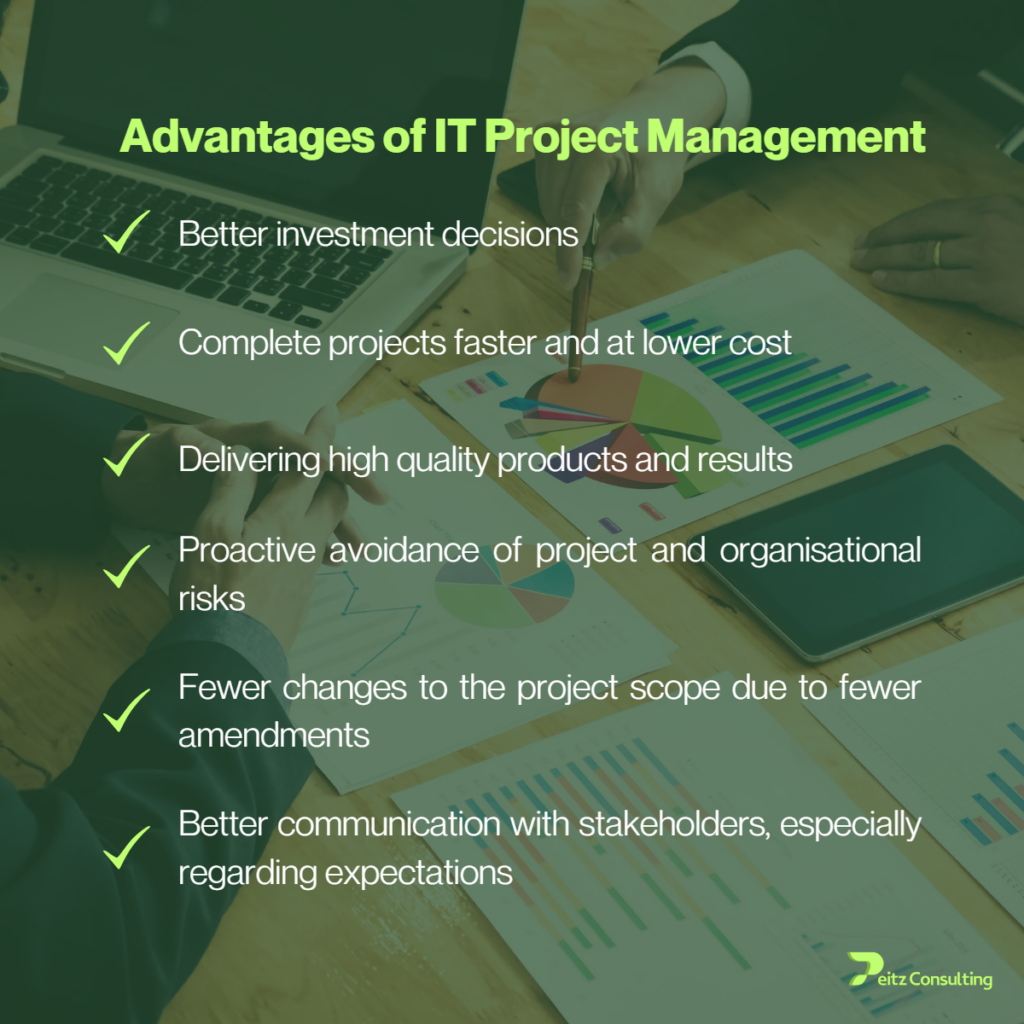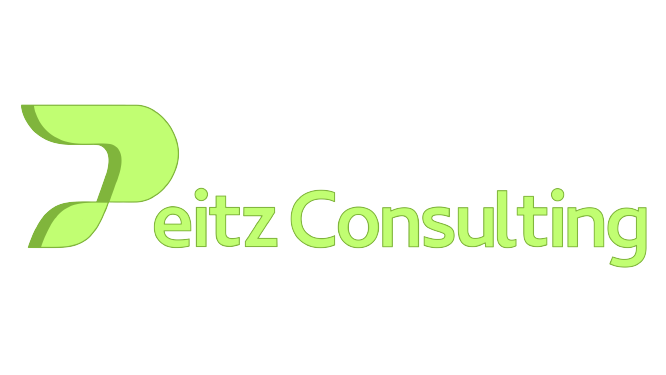IT Project Management: key points and methods
IT Project Management is a variant of general project management that refers to the initiation, planning, implementation and completion of IT projects. IT projects are for example:
- Introduction of usually more extensive software
- Development and optimisation of websites or web applications
- Migration projects in the context of software changes or major version changes
- Projects to expand an IT infrastructure
- Projects to link different IT components
- Projects to outsource services previously provided internally to external service providers
- Projects for the maintenance or re-engineering of large IT systems
IT Project Management not only includes the classic tasks of project managers, but is also characterised by the fact that IT project managers are the human interface between application development and users. Therefore, they must have particularly strong interpersonal skills in the areas of communication and leadership as well as a certain level of technical knowledge.


Methods of Project Management
A project management method is a system of principles, techniques and procedures used by people working in the same discipline. The main methods differ not only in their structure, but also in the type of deliverables, work processes and even project management software.
Waterfall method
In this method, all project steps are worked through one after the other until the project is completed. This method can be used when the requirements are stable and the team is small.
Compared to other methods, the waterfall method focuses mainly on a series of clear and defined steps. The structure is simple as every project goes through these steps: Requirements gathering and documentation, system design, implementation, testing, delivery/implementation and maintenance.
With this method, a fixed goal can be set at the beginning from which the teams should not deviate. For small projects with clear goals, this step ensures that the team is clear about the overall goal from the beginning and is less likely to get lost in the details as the project progresses.
In addition, the methodical waterfall approach leads to a clear transfer of information at each step. Even if this is not the case in your organisation, it is advisable to document information throughout the project life cycle. Whether you hand off projects at every step or have unexpected staff changes, the waterfall approach prioritises accessible information so that new staff can quickly learn the ropes when needed.
Phases of the waterfall concept:
- Gathering and documenting requirements: This is about gathering comprehensive information about what the project requires. You can gather this information in different ways, from interviews and questionnaires to interactive brainstorming. At the end of this phase, the project requirements should be clear and you should have a requirements document that has been distributed to your team.
- System design: After the requirements are defined, your team designs the system. In this phase, coding does not take place, but the team defines specifications, e.g. for the programming language or the hardware requirements.
- Implementation: In this phase, programming takes place. The programmers take the information from the previous phase and create a functional product. They usually implement the code in small pieces that are integrated at the end of this phase or at the beginning of the next phase.
- Testing: Once all the code is ready, product testing can begin. The testers find problems and report them methodically. If serious problems occur, your project may need to return to the first phase to be re-evaluated.
- Delivery/installation: The product is completed and your team submits the products to be installed or launched.
- Maintenance: The product has been delivered to the customer and is in use. If problems occur, your team may need to create patches and updates to fix them. Again, you may need to go back to phase one if there are serious problems.
Traditional project management offers the following advantages:
- Easy to understand and apply
- Ideal for small projects with clearly defined requirements
- Efficient way to complete the project
- Easy to track the progress of the project
- Useful for risk management
- Maximum control over the project
- The project manager has a clear overview of the project
- Detailed documentation is available
On the other hand, there are the following disadvantages:
- Not recommended for large and complex projects
- Low flexibility, not easily adaptable to changes
- Takes a long time to complete the project
- Not suitable for projects with rapidly changing requirements
- Requires a high level of discipline from team members
- Team members can feel micromanaged
- Documentation can be extremely lengthy
Agile project management
In the agile project methodology, projects are divided into small parts. These project parts are completed in work sessions, often called sprints. Sprints usually last between a few days and a few weeks. These sessions range from the initial design phase to testing and quality assurance (QA).
The agile methodology allows teams to gradually release each segment as it is completed. This continuous release schedule allows teams to show that these segments are successful and, if not, to quickly fix bugs. This is thought to help reduce the likelihood of large-scale failures as continuous improvement occurs throughout the project lifecycle.
It also does not require the presence or involvement of a project manager. Whereas in traditional project delivery methods such as the waterfall model, a project manager is essential for success – here he or she manages the budget, staff, project scope and other key elements – in APM, the project manager’s role is distributed among team members.
Given the shift of work from project managers to agile teams, agile project management requires that team members know how to work within this framework. They need to be able to collaborate with each other and with users to keep projects on track. They also need to be able to take the right actions at the right time to meet delivery deadlines.
The five phases of agile project management:
- Visualisation: The project and the overall product are first conceptualised and the needs of the end customers are identified. This phase also determines who will work on the project and who the stakeholders are.
- Speculation: In this phase, the initial requirements for the product are created. Teams work together to create a list of features of the final product and then set milestones for the project timeline.
- Exploration: The project focuses on meeting the project specifications, but the teams also explore alternatives to meet the project requirements. Teams work on individual milestones and iterate before moving on to the next.
- Adaptation: The results are reviewed and the teams adapt them as needed. This phase is about changes or corrections that arise from the customers’ and employees’ point of view. Feedback should be given constantly to ensure that every part of the project meets the needs of the end users. The project should improve with each iteration.
- The results are reviewed and the teams adjust them as needed: The final project is compared to the updated requirements. Errors or problems that occur during the process should be reviewed to avoid similar problems in the future.
Advantages of agile project management:
- Designers have more freedom to work on models that play to their strengths.
- Efficient use of resources, which enables rapid implementation
- Increased flexibility and adaptability to changing requirements
- Quicker identification of problems, allowing for faster solutions
- Increased collaboration with users, resulting in products that better meet user needs
- Compared to traditional project management methods, such as waterfall, no clearly defined goals and processes are required at the beginning of development
However, the following disadvantages are noted:
- It requires a high level of discipline from team members
- Team members can feel overwhelmed
- Not suitable for small projects with clearly defined requirements
- Documentation can be extremely lengthy
In a hybrid approach, the project is first planned using the traditional method. Then the agile method is used for execution. This method combines the best of both worlds and gives the project manager more control over the project. It also helps to reduce the risks associated with the project. It is best suited for large, complex projects and for projects with rapidly changing requirements. In summary, the method to choose depends on the type of project and the requirements of the project.
Other methodologies
- Scrum
- PRINCE2
- PERT
- Adaptive project framework
- Extreme Programming (XP)
This methodology, which also has its roots in the agile framework, was developed by Kent Black in the 1990s. It is a short life cycle methodology whose main goal is to improve product quality and customer satisfaction. Its characteristics and principles require a management team that strives for excellence in the development process. In his book Extreme Programming Explained, Kent Black explains that the method is gaining momentum because “…XP is particularly well suited to helping small software development teams succeed.”
- Kanban
The Kanban project management process omits the sprints and milestones attributed to Scrum and traditional management methods respectively. What we do find, however, is a more visual approach to time management, project size and budget; these three factors determine the success of any project.
This method was developed in the 1940s by the Japanese company Toyota. The idea behind Kanban is continuous delivery, especially when combined with the Scrum method. It uses a system of visual cues that inform the project team what is expected of the tasks within the project in terms of quantity and quality and when the tasks should be executed.
How do I choose the right method for my project?
There are many offshoots and hybrids of the methods described above that have led to fantastic results. The problem, however, is finding the right approach to managing your projects, because these approaches only serve as a starting point, and the approach used can make the difference between a project’s success or failure. Here are some points to guide you:
- Ask team members what has worked well in the past. This will help you narrow down the options.
- The requirements or expectations of your clients should be clearly defined. Note that requirements can be fixed or dynamic.
- Outline the organisation’s objectives and also consider the cost of the project.
- How will the team be composed: Is it virtual or physical? Will some of the work be outsourced?
- It is perfectly acceptable to select different positive elements from each method to create a process that can work wonders for your team.
Visit our Project Management section for more information on the services we offer in this area.

Your transformation is our passion.
KONTAKT
+49 7162 94 72 079
kontakt@peitz.consulting
Sonnenstraße 10, 73650 Winterbach Deutschland
MENU
Copyright 2023 Peitz Consulting. All Rights Reserved.